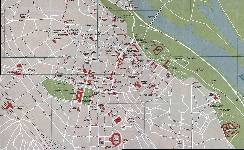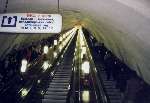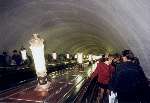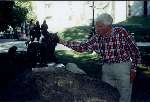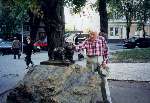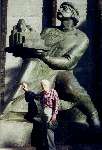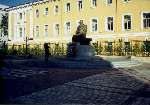|
Introduction |
TRIP TO UKRAINE
|
||
|
Tuesday, September 21, 1999
KYIV METRO |
|||
|
In Soviet style, the tracks are very deep underground, so the escalators are the longest, steepest, and fastest I had ever seen, a real challenge to get on and off. We rode two sections like the one shown here to reach the trains. As you can see, it was very busy even at this hour, around 2:30 p.m. We got some strange looks, as there were few other tourists in sight. Our guide had given us good directions, but it still took a while - and several stops to ask questions - to understand the route we took. No one speaks English, or any foreign language other than Russian, so Dad came in very handy! The three stations we visited were Universytet, where we got on, Teatral'na, where we transferred, and Zoloti Vorota. The last two are really one station, which confused us, of course. We took a tunnel from Teatral'na to Zoloti Vorota, where we exited to the street, and our destination - Zoloti Vorota means Golden Gate. |

 |
||
|
KYIV's GOLDEN GATE I asked "Is this the 'Great Gate of Kyiv'?" (a la Moussorgsky's Pictures at an Exhibition), and was told "Oh, yes." But a couple of web sites I checked say "No," that gate was purely fanciful, an image created by an artist and seen by the composer in a painting at an Exhibition in St. Petersburg in 1874. |
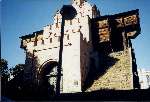
|
||
|
To one side of the Gate was this bronze cat - Dad had to pet it. The story I found on the www is that the statue was put there by the owner of a nearby restaurant, who was saved from a fire by the cat. |
|||
|
Statue of Yaroslav The Wise, holding a model of Saint Sofia Cathedral. To celebrate his decisive victory over the Pechenegs in 1036 (who thereupon never were a threat to Kiev) Yaroslav the Wise sponsored the construction of the Saint Sophia Cathedral in 1037. (from Wikipedia) Yaroslav also built the Golden Gate, and other important structures in Kiev. |
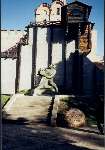
|
||
|
The Gate, from what would have been the inside of the walled city. This reconstruction was part of the 1982 celebration of the 1500th anniversary of the founding of Kyiv. |

|
||
|
The interior of the structure around the Gate is now a museum, and one can climb around inside the gate itself. Here's a nice model of the gate, as it might have looked shortly after completion, with the tiny Church of the Annunciation om top. |
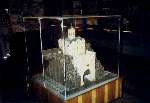
|
||
|
At right, a wonderful map, showing Kyiv in the 11th century - looking to the south, the Gate is at the bottom, the Dnieper River at left and top. St. Sophia is at number 4. Link to a picture of a wonderful diorama showing Kyiv shortly after the Gate was built. The view is to the north, with the Gate at the bottom, and the Dnieper River at the top. St. Sophia is the largest building, left of center. Apparently it has fallen into disrepair. It was still in decent shape when we visited. |

|
||
|
Great views from the top of the Golden Gate. One Internet site explains the name thus:
Another site said it was called the Golden Gate because the sun shown through its openings each morning (just as the Golden Gate in California is called that because the setting sun filled it when the first European explorers saw it). |
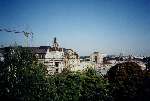
|
||
|
To one side of the Gate were this charming fountain and outdoor café. |

|
||
|
We walked downhill a few blocks east to Kreshchatyk street, the chic place to be seen. Most major intersections in Kyiv have underground passage-ways for pedestrian traffic. We used them, but I was still very nervous about crowds, having been warned of pick-pockets, and worse, so did not try any photos there. Most had small shops, and often there were entertainers. |

|
||
|
It was getting late. We walked two blocks down Kreshchatyk to Taras Schevchenko Blvd., where we turned right towards our hotel. A few blocks further on we passed Shevchenko University. In front of one of its buildings was this popular statue of Mykhailo Hrushevsky, famous Ukrainian historian, patriot, and President of the 1918 Ukrainian National Republic. |
|||
|
One of the few small (7-11 type) stores that had a name (most just said Food or Bread or Milk) - this one was called "Starlet". |

|
||
|
BUYING STAMPS
Back at the hotel, I wanted to send some postcards to friends, and found a few in the lobby gift shop, but they had no stamps. I asked at the front desk, and was directed to a man with a small refreshments stand in another corner of the lobby. It took a while to communicate what I wanted, as he did not speak English, but eventually he understood I wanted stamps for postcards to the US. He gave me my stamps in postal envelopes of the USSR, whic surprised me at first - as a stamp collector, I think of any postal product as still worth at least its initial value, but of course to this man these were now just scrap paper. He did his math on them to determine what I owed him. |
|||
Send feedback to the author: CLICK HERE
Created -- 03/22/2007 Revised -- 03/22/2007
